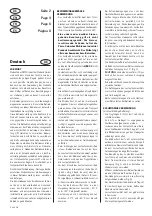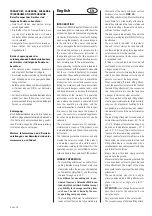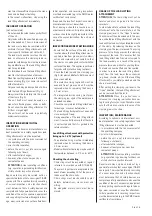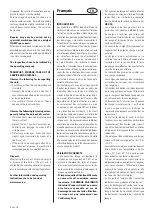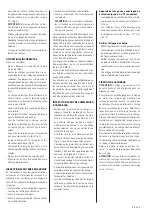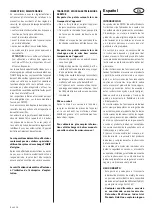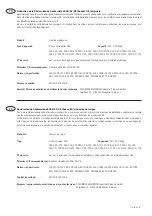
5 von 16
ment must have suffi
cient space in the crane
hook and be freely articulating.
- In the case of malfunctions, stop using the
load lifting attachment immediately.
INCORRECT OPERATION
(List not complete)
- Do not exceed the rated load capacity (WLL)
of the unit.
- Only loads within the specifi ed jaw capacity
must be picked up. The min. dimensions of
the load must always be complied with in
particular for load lifting attachments with
a jaw capacity that does not start with 0.
- The load must never be less than the min.
load, as otherwise the clamping force re-
quired for safe transport will not be reached.
- Any modifi cations of the load lifting attach-
ment are prohibited.
- It is forbidden to use the load lifting attach-
ment for the transportation of persons.
- When transporting loads ensure that the load
does not swing (Fig. 1) or come into contact
with other objects.
- Only one load may be transported at a time
with the load lifting attachment (Fig. 2).
- Always insert the load fully into the mouth
of the clamp (Fig. 4).
- The unit itself must never be used as a
means for attaching ropes, chains or belts.
- Do not allow the load lifting attachment to
fall from a large height.
- The unit must not be used in potentially
explosive atmospheres.
INSPECTION BEFORE INITIAL
OPERATION
According to national and international acci-
dent prevention and safety regulations load
lifting attachments must be inspected:
• in accordance with the risk assessment of
the operating company,
• prior to initial operation,
• before the unit is put into service again
following a shut down,
• after substantial changes,
• however, at least once per year, by a
competent person.
ATTENTION:
Actual operating conditions
(e.g. operation in galvanizing facilities) can
dictate shorter inspection intervals.
Repair work may only be carried out by a
specialist workshop that uses original TIGRIP
spare parts. The inspection (mainly consisting
of a visual inspection and a function check)
must determine that all safety devices are
complete and fully operational and cover the
condition of the unit, suspension, equipment
and supporting structure with regard to dam-
age, wear, corrosion or any other alterations.
Initial operation and recurring inspections
must be documented (e.g. in the CMCO works
certifi cate of compliance).
If required, the results of inspections and ap-
propriate repairs must be verifi ed.
Paint damage should be touched up in
order to avoid corrosion. All joints and sliding
surfaces should be slightly lubricated. In the
case of heavy contamination, the unit must
be cleaned.
INSPECTIONS BEFORE STARTING WORK
- Ensure that the surface of the load, in the
location where the load lifting attachment is
applied, is free from grease, paint, contami-
nation and scale and is not coated, so that
the clamps can make good contact with the
surface of the load. This applies in particular
for grabs with protective lining (optional).
- Check the fi xed jaw and the clamping jaw
(Fig. 5) for wear and defects. Both jaws must
have clean profi les.
- The protective lining (optional) must be
even and free of grease and oil. It must be
replaced when its remaining thickness is
2,5 mm or less.
- The integrated torsion spring must press
the clamping jaw against the workpiece in
unloaded condition.
- Check the complete load lifting attachment
for damage, cracks or deformations.
- The load lifting attachment must open and
close easily and freely.
- During operation of the load lifting attach-
ment it is essential to ensure that the chain
is not twisted and that it is guided in the
return sprockets.
Load lifting attachment with protective
lining up to 1.25 t (optional)
- The protective lining must be immediately
replaced when its remaining thickness is
2,5 mm or less.
- Models with protective lining may be used at
temperatures between –20° C and +60°C.
Checking the chain sling
- Chain slings must be inspected at regular
intervals in accordance with DIN 685-5.
They must in particular be replaced in the
event of wear exceeding 10% of the nominal
thickness of the chain links.
- Chain slings must be checked for outer
defects, deformations, cracks, wear and
pitting.
An elongated or worn chain must be re-
placed.
USAGE OF THE LOAD LIFTING
ATTACHMENT
ATTENTION:
The chain sling must not be
twisted and must be guided in the return
sprockets.
In order to be able to set down the load lifting
attachment onto the metal plate, pull the
clamping jaw lever in the “Open” direction.
The chain must then be unloaded. In this posi-
tion, slide the load lifting attachment onto the
load until the load has fully entered the mouth
of the clamp. By releasing the lever on the
clamping jaw, the jaw is released. The spring
pressure force fi rmly presses the clamping
jaw against the load. This ensures that the
load lifting attachment remains clamped to
the load precisely as a result of the spring
pressure force also without any pulling force.
The load can now be lifted and transported.
In order to remove the load lifting attach-
ment from the load, lower the suspension
(e.g. hook, shackle, etc.) until the load lifting
attachment is completely unloaded and the
chain moves freely.
After pulling the clamping jaw lever in the
“Open” direction, the load lifting attachment
can be removed from the load.
ATTENTION:
When the pulled lever is
released, the clamping jaw lashes back ow-
ing to spring force (no lock). Therefore make
sure that there are no limbs in the area of the
clamping jaw or the chain.
INSPECTION / MAINTENANCE
According to national and international acci-
dent prevention and safety regulations load
lifting attachments must be inspected:
• in accordance with the risk assessment of
the operating company,
• prior to initial operation,
• before the unit is put into service again
following a shut down,
• after substantial changes,
• however, at least once per year, by a
competent person.
ATTENTION:
Actual operating conditions
(e.g. operation in galvanizing facilities) can
dictate shorter inspection intervals.
Repair work may only be carried out by a
specialist workshop that uses original TIGRIP
spare parts. The inspection (mainly consisting
of a visual inspection and a function check)
must determine that all safety devices are
complete and fully operational and cover the
condition of the unit, suspension, equipment
and supporting structure with regard to dam-
age, wear, corrosion or any other alterations.
Initial operation and recurring inspections
must be documented (e.g. in the CMCO works
certifi cate of compliance).
Summary of Contents for TIGRIP TAG
Page 13: ...13 von 16...


